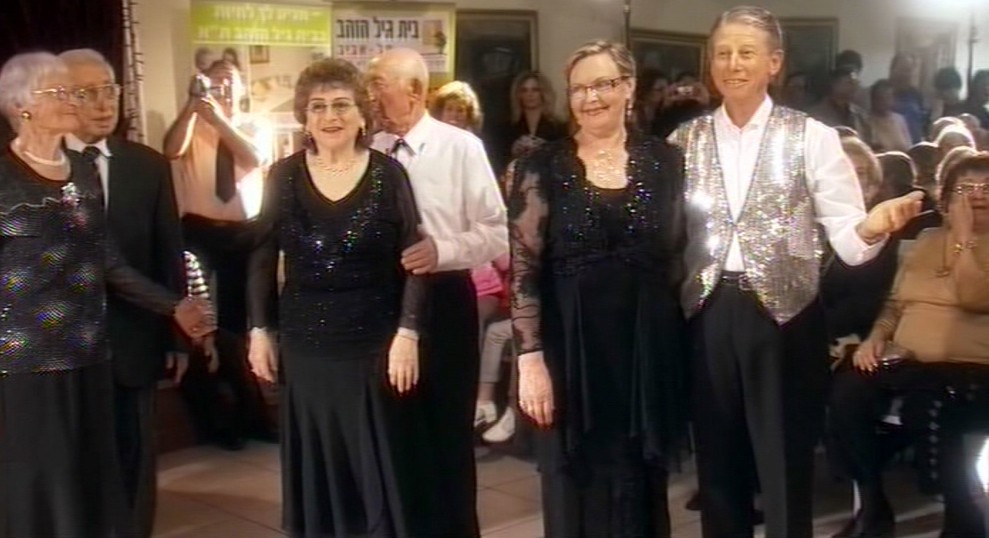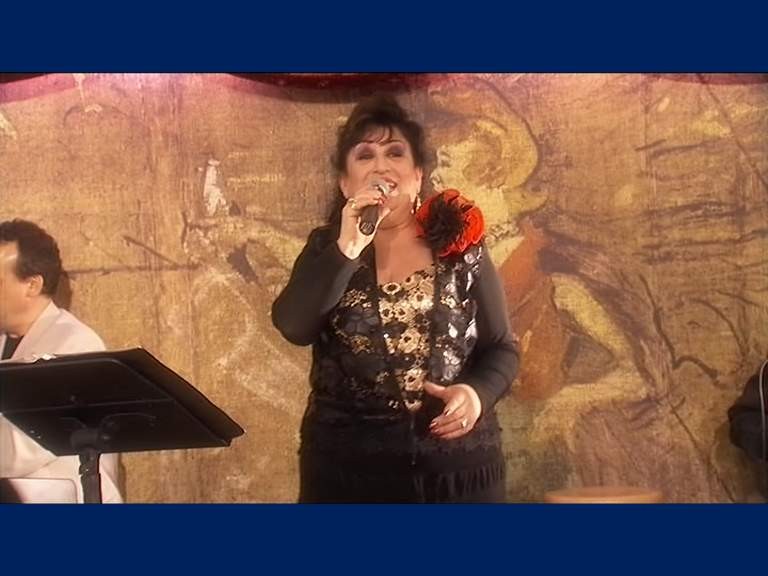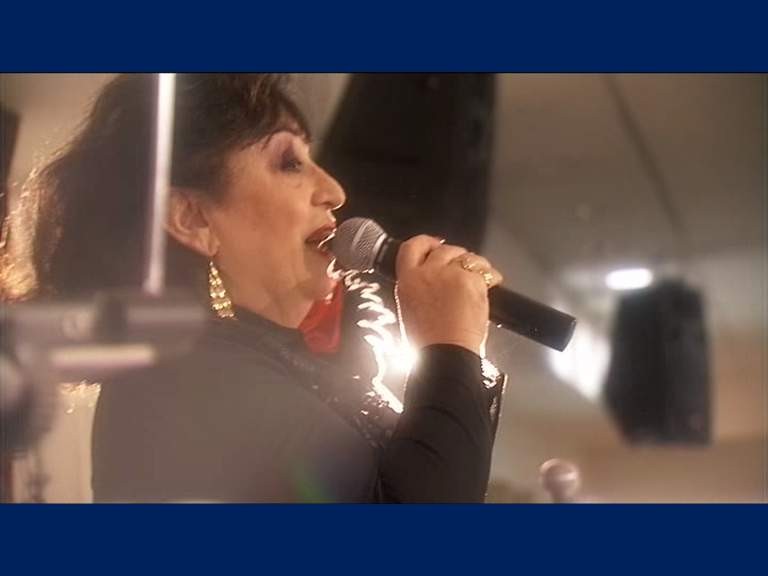Once a year in Ida's club, a ballroom dancing competition takes place. All the competitors are way past retirement age, but that doesn’t stop them from dancing and singing, to falling in love and being disappointed. The competition participants hardly know one another outside the club walls, but their lives, full of problems, are gradually revealed to us. The magical atmosphere of the club and the ballroom dancing, gives them the strength to overcome the wear and tear of time, the health problems and difficult memories. They become princes and princesses, for whom anything is still a possibility.
Synopsis
Once a year in Ida's club, a ballroom dancing competition takes place. All the competitors are way past retirement age, but that doesn’t stop them from dancing and singing, to falling in love and being disappointed. The competition participants hardly know one another outside the club walls, but their lives, full of problems, are gradually revealed to us. The magical atmosphere of the club and the ballroom dancing, gives them the strength to overcome the wear and tear of time, the health problems and difficult memories. They become princes and princesses, for whom anything is still a possibility.
Awards
- Gold Remi Award - WorldFest Houston International Film Festival, USA, 2010
- The Gold Kahuna Award for Excellence in Filmmaking - Honolulu International Film Festival , 2010
- The National Lottery Prize for Art & Culture for the film that was best distributed to the periphery, Israel, 2009
Festivals
- Bucharest Jewish Film Festival, Romania, 2011
- Detroit Jewish Film Festival, USA 2011
- Sid Jacobson Jewish Film Festival, USA 2011
- White River International Indie Film Festival, USA, 2011
Press & Links:
The stories of the individual participants were at once funny, poignant and heart-rending. Dance represented a way that these folks could get together and forget their personal woes, past and present, and express themselves with an exuberance that any person could strive for, at any stage of life.
For the entire review by Maryam Rostami, check: http://athomewithgrowingold.com/dancing-about-architectureFilmmaker Dalit Kimor focuses her lens on a Tel Aviv ballroom dancing club for senior citizens-the majority being emigrants who, it seems, never truly assimilated into Israeli life. The organization offers a welcome refuge, where the burdens of old age almost vanish when the music starts and the eponymous Ida (a one-time Russian singer) performs Hebrew-language versions of Broadway show tunes. The film's central focus is a Dancing With the Stars-style competition, and the level of fancy footwork that participants bring to the dance floor is wonderfully surprising. Yet Kimor avoids falling into the trap of a feel-good production, providing snapshots of the harsh and often tragic lives of several individuals-one woman cares for an ill adult child, while another's daughter refuses to visit her for the Rosh Hashanah holiday. Surprisingly, the final competition doesn't dominate Ida's Dance Club, since we see only the briefest glimpses of the contestants in their finest hour, along with some grumbling from a pair eliminated from the finals. Instead, this unsentimental film provides a compelling look at how a handful of seniors manage to keep moving (literally and figuratively) through the late stretches of their lives.
Recommended.
Aud: C, P. (P. Hall)
The Video Librarian, USA
Israeli filmmaker Dalit Kimor helmed this compelling documentary about a Tel Aviv ballroom dancing club for senior citizens – the majority are emigrants who, it seems, never truly assimilated into Israeli life.
The club offers a welcome refuge for its participants and the burdens of old age almost magically vanish when the music starts and the eponymous Ida (a one-time Russian singer) sings out Hebrew-language versions of Broadway show tunes. The film’s central focus is a “Dancing with the Stars”-style competition for the club’s participants, and the level of flash and footwork that they bring to the dance floor is wonderfully surprising.
Yet Kimor avoids falling into the trap of a feel-good film. The film offers a look into the harsh and often tragic lives of several elderly dancers – one woman has to care for her ill adult daughter, while another woman’s daughter refuses to visit her for the Rosh Hashanah holiday. The balance between reality and dancing becomes jarring, especially with the footage when several seniors watch from chair-bound infirmity while their upper torsos sway to the music that their legs and feet can no longer follow.
For the entire review check: http://www.filmthreat.com/reviews/23125/
Recommended
One Generation Dances, Another Generation Comes Along With hardly any publicity, “Ida’s Dance Club,” a documentary film about a ballroom dance competition for the elderly has turned into a hit among old-timers and youngsters alike at the Tel Aviv Cinematheque. Shmulik Duvdevani watched it and loved it.
Quietly, without any publicity or P.R., the best party in town takes place every Saturday morning. The place: The Tel Aviv Cinematheque. “Ida’s Dance Club,” the documentary film by director Dalit Kimor and producer Yael Shavit, has been screened there for a few weeks now and has turned into the Rocky Horror Picture Show of the older generation.
The youngest old-timers in Israel come to the club in southern Tel Aviv, break up into couples, and take part in an annual ballroom dance competition. Kimor’s camera almost never leaves the club, which is run by the colorful matron mentioned in the film’s title, and documents the liveliness and excitement that turn the few hours they spend there into a truly magical experience.
“Ida’s Dance Club” – The Rocky Horror Picture Show of the Older Generation
It’s not that “Ida’s Dance Club” ignores what happens to its characters outside of their fantasy in which they turn into princes and princesses for a few hours at a time. On one hand we have a woman dealing with her anorexic daughter, and on the other hand a man who’s hiding a hair-raising story about an encounter with Mengele when he was a boy during the Holocaust. But all these things are forgotten when the group hits the dance floor.
And what touching moments Kimor captures with her camera! Two English-speaking sisters whose collective age is almost 180 sing the song “Sisterly Love” which they wrote as little girls; a suave man, the idol of a few of the club’s female denizens, reveals the truth about his sexual identity to the camera, and that’s just the beginning.
Ida. A Magical Experience Untroubled by the Outside World
On the surface, the idea of a film about old folks dancing seems predictable and formulaic - just another movie about the last happy moments in life. So more than anything else, this film is surprising. Kimor treats her characters, their stories and their fantasy world with such commendable respect and delicacy. The tears in the corners of the eye are tears of joy.
What happens in the Tel Aviv Cinematheque’s small hall is also an inseparable part of the celebration on the silver screen. Dozens of people young and old pack the place – rumors about the movie have spread by word of mouth. The dancers themselves, led by Ida, come to the hall every week in one in one combination or another, and the director introduces them at the end of the screening. This may not sound like anything to write home about, but at that moment I felt like taking one of them by the hand and breaking into a little dance in celebration of life itself.
Shmulik Duvdevani / YNET, July, 2009
A Romantic Dance
How did the documentary “Ida’s Dance Club” become a cult film that draws in senior citizens as well as curious youngsters?
In local terms, this is a real phenomenon. Every Saturday morning, while most of us are still sleeping, a group of enthusiastic seniors gathers to watch a documentary film that describes the preparations for the yearly dance competition at Ida’s Dance Club. All of the competitors have already passed retirement age, but that does not stop them from enjoying the spirit of youth. Filmmaker Dalit Kimor entered their world as a welcomed guest and has succeeded in conveying their sense of mischief, as well as their distress.
…in addition to Ida, the master of ceremonies who is a talented choreographer and singer, the real heroes of the story are the dancers themselves. The dance competition gives them a chance to show off their dance skills as well demonstrating a joy for life which does not always come easily at their age.
But the greatness of the film is that Kimor does not resort to cheap emotional manipulation. During the entire film she guards her characters’ dignity even as she focuses on some of their personal problems; problems ranging from the betrayal of the body to the burden of memories that this generation carries. Almost all of the characters in the movie are either Holocaust survivors, or people who have experienced the pain of exile.
Another wonderful quality of the film is the use of humor – which mainly comes from the characters themselves who use wit along side dancing as a coping mechanism. Kimor’s gentle editing style manages to preserve these tender moments.
One such moment is when the charming Benny arrives at the dance club. The women in the room immediately take note of his South African accent and impeccable dress and all want him as their dance partner…
Julia is the real star of the film and it is no mistake that she is the one at the center of another scene which leaves the audience roaring with laughter. This is a scene where members of the dance club come to visit her in the hospital where she is staying because of leg injuries. This should be a very sad moment, but this is actually where we see Julia in all her glory. She has fashioned a new get-up out of hospital pajamas and wearing high-heels as she dances to the delight of the hospital staff and we in the audience.
Out of the mosaic of characters in the film, Julia is the most poignant. Along side her zest for life, we also see the challenges she faces. She hardly speaks Hebrew and lives modestly without any family.
Kimor wisely travels between laughter and tears and treats her characters with respect – thus gaining their trust. For example, the scene where Pinchas and his partner are interviewed for a TV show and they give short to-the-point answers. But as soon as the crew leaves, they open up to Kimor and her camera and he talks about his memories as a child in the Holocaust.
“Ida’s Dance Club” was first screened as part of DocAviv last spring. After the showing the director of the Tel Aviv Cinematheuque suggested to Kimor that they turn her film into a cult movie for seniors along side another documentary “The Worst Company in the World”. They decided that 11:30am was a suitable time for this crowd and it has been showing ever since. Initially characters from the film would show up too – which helped spread the word about the film. Now-a-days they take turns attending screenings. At a recent screening Julia appeared after the film with a dance –“Just like in The Purple Rose of Cairo” Kimor said of the performance.
The combination of happiness and laughter, lots of music and dancing along with depth and smart movie-making have made the film enjoyable for audiences of any age. Next time you are wondering what to do on a Saturday morning, it is a good idea to go over to the Cinematheque and enjoy a group of seniors who have decided to survive with dignity – and “bring your parents too” says the director Dalit Kimor.
Yoad Earon/Walla! com, November, 2009
http://e.walla.co.il/?w=/6/1603232 Dance Until You Drop
A small and intimate and adorable documentary reminded me of what is currently missing from commercial television; deep emotion, humor and elegance.
Dalit Kimor's film has become a cult film for those in the know. It is a film that deals with a ball-room dance competition for senior citizens and the stories of those who participate in the competition. So many dreams and disappointments. So much pain and jealously. But there is also love, and compassion and warmth and humanity. All of this is siphoned into one film that even without the Tango music will continue to resonate for future generations.
Let's begin with the plot; there is a central story which includes the first dance competition and the crowning of a winner. Everything that occurs in between is nerve-wracking and takes place in private homes and public dance halls. The characters are strong and impressive in their strength and nobility. Julia is old and sickly, and commands the dance floor. She says about her self that inside she is 18 years old. "If I stop dancing then I will die" is how she explains her passion.
Every character has a story and it is critical that there will continue to be those who want to tell and also broadcast their stories. To say that this is a winning film is almost insulting - besides somewhat sloppy filming, IDA'S DANCE CLUB is near perfection.
Israel Today, June 15th, 2010, Shir Ziv
An alluringly beautiful film. It has already been running for 37 weeks straight at the Tel Aviv Cinematheque – moving to tears. And at the end of the screening some of the participants get up on stage and start dancing.
For the entire article by Aviva Lori, Haaretz, check:
http://www.haaretz.com/hasen/spages/1152045.html
The ESRA Cinema Club was treated to a very uplifting movie on August 25. This movie was centered on a Senior Citizen’s Dance Club in Tel Aviv where twice a week retired people come to dance and sing and forget their troubles.
The director, Dalit Kimor, told us this was a fly-on-the-wall production. She didn’t have any funding for the movie but with a student cinematographer, she immersed herself in the atmosphere of the Club and soon the people there forgot she was around. The down-to-earth movie was a hit, and now TV Channels and Cinemateques are clamoring to show it.
The people she mirrored all came from different backgrounds, and as 99% of the dancers are all olim, it was an interesting mix of people, some funny, some sad, some eccentric, but mostly all of them felt that Ida’s Dance Club gave them the chance to be young again and gave them hope of winning the 2008 Dance Competition, by sashaying their way through the Tango and Paso Doable.
Ida, who runs the Club, is a larger-than-life ex opera singer from Russia and her vitality and strength shows why her Club has over 100 people each Saturday night dancing, singing and generally letting their hair down.
Dalit’s film took us from the choosing of partners, through to the rehearsals and on to the big night of the Competition, where the competitors all looked like something out of a Hollywood movie. The women wore spiky heels and glamorous dresses, while the men wore tuxedos. As they took to the floor, one by one in front of the judges, all the misery in their lives was totally forgotten, and the most important thing was the music and the dance steps.
Julie Andrews once sang “A spoonful of Sugar helps the medicine go down”. Surely Ida’s Dance Club is the sweetest thing on earth to these lovely people.
ESRA Magazine, reviewed by Sara Groundland"Viewed "Ida's Dance Club" at my synagogue and its integrity, honesty, pathos, and authenticity made me proud to be a Jew. Thank you and please continue with your film efforts."
Rachel Cohen, Rhode Island, USA
The National Lottery Prize for Art & Culture for the film that was best distributed to the periphery was awarded to IDA'S CLUB directed by Dalit Kimor and produced by Yael Shavit.
The film was granted the prize for its warmth and humor. The prize committee is confident that audiences will fall in love with the film's unique characters. Furthermore, Dalit Kimor's film
instills a sense of faith in human beings and inspiration in the power of individuals to live with dignity at any age or under any circumstances.
Festivals
- Bucharest Jewish Film Festival, Romania, 2011
- Detroit Jewish Film Festival, USA 2011
- Sid Jacobson Jewish Film Festival, USA 2011
- White River International Indie Film Festival, USA, 2011
- Legacy Film Festival, USA, 2011
- Detroit Jewish Film Festival, USA, 2011
- Filmmor International Women Film Festival, Turkey, 2011
- Calgary Jewish Film Festival, Canada, 2010
- Palm Beach Jewish Film Festival, USA, 2010
- Hong Kong Israeli Film Festival, 2010
- Kos International Film Festival , Greece, 2010
- Louisville Nursery Home, USA, 2010
- Abruzzo International Documentary Film Festival, Italy, 2010
- Chicago Festival of Israeli Cinema, USA, 2010
- WorldFest Houston International Film Festival, USA, 2010
- Bnai Brith Synagogue Washington DC, 2010
- Magen David Temple, Washington DC, 2010
- Palm Beach International Film Festival, USA, 2010
- Jacob Burns Film Center, USA, 2010
- Delray Beach Int'l Film Festival, USA, 2010
- Temple Beth El, Providence, USA
- Toronto Jewish Film Festival, Canada, 2010
- Honolulu International Film Festival, 2010
- Isratim Film Festival, Paris, 2010
- India Int'l Women Film Festival, Special Showcase for Ruth Diskin Films, December 2009
- DocAviv Int'l Film Festival, Tel Aviv, Israel, 2009
- Women Film Festival, Rehovot, Israel, 2009
Educational
- Harvard University
- Library of Congress
- York St. John University, UK
- University of Pennsylvania
- Arizona State University
- Milwaukee Jewish Resource Center
Awards
- Gold Remi Award - WorldFest Houston International Film Festival, USA, 2010
- The Gold Kahuna Award for Excellence in Filmmaking - Honolulu International Film Festival , 2010
- The National Lottery Prize for Art & Culture for the film that was best distributed to the periphery, Israel, 2009






